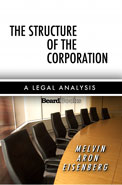
|
The Structure of the Corporation: A Legal Analysis
By Melvin Aron Eisenberg
2006/09 - Beard Books
1587982889 - Paperback - Reprint - 352 pp.
US$34.95
A detailed legal examination of the inner workings of the modern publicly held corporation.
Publisher Comments
This book examines the roles of officers, directors, and shareholders in the governance of the modern publicly held corporation. The book shows that these corporations are managed by the senior executives, not by the board of directors. The role of the board is not to manage, but to select the managers, monitor the managersí conduct of the corporationís business, and approve major changes in the corporationís legal or business structure. To this end, the board should be composed of a majority of independent directors, and for certain purposes those directors should be constituted as a separate corporate organ. To perform its monitoring function, the board must have reliable information on the corporationís financial performance by outside independent accountants. The book also shows that the shareholdersí voting right is very important, because with the rise of institutional shareholdings, share ownership is much more concentrated than was previously believed. Finally, the book develops the importance of appraisal rights, especially as an ultimate check on managerial conflicts of interest in structural transactions, such as mergers. This volume belongs on the shelves of lawyers and businessmen. 
No book reviews available.

 Melvin Aron Eisenberg is Koret Professor of Law at School of Law, University of California, Berkeley. In addition to a distinguished teaching career, he was in private practice and also served as assistant counsel to the Presidentís commission on the assassination of President Kennedy (Warren Commission). He is the author of numerous books, and is presently a consultant to the American Bar Associationís Committee on Corporate Law. Melvin Aron Eisenberg is Koret Professor of Law at School of Law, University of California, Berkeley. In addition to a distinguished teaching career, he was in private practice and also served as assistant counsel to the Presidentís commission on the assassination of President Kennedy (Warren Commission). He is the author of numerous books, and is presently a consultant to the American Bar Associationís Committee on Corporate Law.

| Preface |
vii |
| 1. |
Introduction: The Received Legal Model of the Corporation |
1 |
| Part I. The Legal Role of the
Body of Shareholders |
7 |
| 2. |
Voting Rights in Closely Held Corporations: A Normative
Model |
9 |
| 3. |
Voting Rights in Publicly Held Corporations: Three Schools
of Thought |
18 |
| 4. |
Voting Rights in Publicly Held Corporations: The
Conflict-of-Interest |
30 |
| 5. |
Voting Rights in Publicly Held Corporations: The
Expectations of Shareholders |
37 |
| 6. |
Voting Rights in Publicly Held Corporations: A Normative
Model |
64 |
| 7. |
The Place of the Appraisal Right in a Normative Model of
the Corporation |
69 |
| 8. |
The Uses of a Normative Model |
85 |
| Part II. Access to the Corporate
Proxy Machinery |
95 |
| 9. |
Access to the Corporate Proxy Machinery in Connection with
the Election of Directors |
97 |
| 10. |
Access to the Corporate Proxy Machinery in Connection with
Matters Other than Election to Office |
128 |
| Part III. Management Service |
137 |
| 11. |
Officers and Directors |
139 |
| 12. |
The Flow of Information to the Board and the Role of the
Accountant |
186 |
| Part IV. Structural Changes:
Corporation Combinations |
213 |
| 13. |
The Stock Modes -- An Introduction: The De Facto and
Equal-Dignity Theories of Statutory Interpretation |
215 |
| 14. |
Stock-for-Assets Combinations |
224 |
| 15. |
Stock-for-Stock Combinations |
238 |
| Part V. Structural Changes:
Contractions and Divisions |
253 |
| 16. |
Contractions: Sell-Offs and Partial Liquidations |
255 |
| 17. |
Corporate Divisions: Spin-Offs, Split-Offs, and Split-Ups |
267 |
| Part VI. Voting and Appraisal
Rights in Parent-Subsidiary Complexes |
275 |
| 18. |
Wholly Owned Subsidiaries |
277 |
| 19. |
Subsidiaries with Public Ownership |
308 |
| 20. |
Conclusion: Normative Models of the Corporation |
316 |
| Table of Cases |
321 |
| Index |
323 |
|
